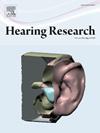Clonidine mitigates noise-induced hearing loss by regulating TRPC6-mediated calcium influx in cochlear hair cells
IF 2.5
2区 医学
Q1 AUDIOLOGY & SPEECH-LANGUAGE PATHOLOGY
引用次数: 0
Abstract
Noise-induced hearing loss (NIHL) is a common auditory disorder driven by calcium overload, oxidative stress, and apoptosis in cochlear sensory hair cells. The transient receptor potential canonical 6 (TRPC6), a nonselective cation channel that can be activated by norepinephrine, is implicated in calcium influx and associated cellular damage. This study explores the protective effects of clonidine, an FDA-approved α2-adrenergic receptor agonist that reduces sympathetic nervous system activity and norepinephrine release, on NIHL in mice. Clonidine treatment significantly preserved hearing thresholds, reduced damage to outer hair cells and ribbon synapses, and suppressed TRPC6 channel activation induced by noise exposure. Mechanistically, clonidine alleviated calcium influx, inhibited the calcium-dependent MLCK-MRLC signaling pathway, and attenuated oxidative stress and apoptosis in cochlear hair cells. Molecular docking analyses demonstrated strong binding between norepinephrine and TRPC6, elucidating the regulatory role of clonidine in calcium signaling. These findings highlight clonidine's potential to prevent NIHL by maintaining intracellular calcium homeostasis and reducing cochlear damage via the modulation of norepinephrine and TRPC6 activity. TRPC6 emerges as a promising therapeutic target for preventing and managing noise-induced auditory dysfunction.
可乐定通过调节耳蜗毛细胞中trpc6介导的钙内流来减轻噪声性听力损失
噪声性听力损失(NIHL)是一种常见的听觉疾病,由钙超载、氧化应激和耳蜗感觉毛细胞凋亡引起。瞬时受体电位6(TRPC6)是一种可被去甲肾上腺素激活的非选择性阳离子通道,它与钙离子流入和相关的细胞损伤有关。克洛尼丁是美国食品及药物管理局批准的一种α2肾上腺素能受体激动剂,可减少交感神经系统的活动和去甲肾上腺素的释放,本研究探讨了克洛尼丁对小鼠 NIHL 的保护作用。氯尼地定治疗可明显保护听阈,减少外毛细胞和带状突触的损伤,并抑制噪声暴露诱导的 TRPC6 通道激活。从机理上讲,氯尼地定可减轻钙离子流入,抑制钙依赖性 MLCK-MRLC 信号通路,减轻耳蜗毛细胞的氧化应激和凋亡。分子对接分析表明去甲肾上腺素与 TRPC6 之间的结合力很强,阐明了氯尼丁在钙信号转导中的调节作用。这些发现凸显了氯尼地平通过调节去甲肾上腺素和 TRPC6 的活性,维持细胞内钙平衡并减少耳蜗损伤,从而预防非耳聋的潜力。TRPC6有望成为预防和控制噪声引起的听觉功能障碍的治疗靶点。
本文章由计算机程序翻译,如有差异,请以英文原文为准。
求助全文
约1分钟内获得全文
求助全文
来源期刊

Hearing Research
医学-耳鼻喉科学
CiteScore
5.30
自引率
14.30%
发文量
163
审稿时长
75 days
期刊介绍:
The aim of the journal is to provide a forum for papers concerned with basic peripheral and central auditory mechanisms. Emphasis is on experimental and clinical studies, but theoretical and methodological papers will also be considered. The journal publishes original research papers, review and mini- review articles, rapid communications, method/protocol and perspective articles.
Papers submitted should deal with auditory anatomy, physiology, psychophysics, imaging, modeling and behavioural studies in animals and humans, as well as hearing aids and cochlear implants. Papers dealing with the vestibular system are also considered for publication. Papers on comparative aspects of hearing and on effects of drugs and environmental contaminants on hearing function will also be considered. Clinical papers will be accepted when they contribute to the understanding of normal and pathological hearing functions.
 求助内容:
求助内容: 应助结果提醒方式:
应助结果提醒方式:


